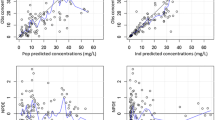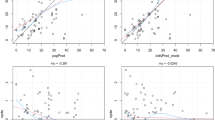Abstract
Background and objective: Meropenem is a carbapenem antibacterial frequently prescribed for the treatment of severe infections in critically ill patients, including those receiving continuous renal replacement therapy (CRRT). The objective of this study was to develop a population pharmacokinetic model of meropenem in critically ill patients undergoing CRRT.
Patients and methods: A prospective, open-label study was conducted in 20 patients undergoing CRRT. Blood and dialysate-ultrafiltrate samples were obtained after administration of 500 mg, 1000 mg or 2000 mg of meropenem every 6 or 8 hours by intravenous infusion. The data were analysed under the population approach using NONMEM version V software. Age, bodyweight, dialysate plus ultrafiltrate flow, creatinine clearance (CLCR), the unbound drug fraction in plasma, the type of membrane, CRRT and the patient type (whether septic or severely polytraumatized) were the covariates studied.
Results: The pharmacokinetics of meropenem in plasma were best described by a two-compartment model. CLCR was found to have a significant correlation with the apparent total clearance (CL) of the drug during the development of the covariate model. However, the influence of CLCR on CL differed between septic and polytraumatized patients (CL = 6.63 + 0.064 × CLCR for septic patients and CL = 6.63 + 0.72 × CLCR for polytraumatized patients). The volume of distribution of the central compartment (V1) was also dependent on the patient type, with values of 15.7 L for septic patients and 69.5 L for polytraumatized patients. The population clearance was 15 L/h, and the population apparent volume of distribution of the peripheral compartment was 19.8 L. From the base to the final model, the interindividual variabilities in CL and the V1 were significantly reduced. When computer simulations were carried out and efficacy indexes were calculated, it was shown that polytraumatized patients and septic patients with conserved renal function may not achieve adequate efficacy indexes to deal with specific infections. Continuous infusion of meropenem is recommended for critically septic patients and polytraumatized patients when pathogens with a minimum inhibitory concentration (MIC) of ≥4 mg/L are isolated. Infections caused by pathogens with an MIC of ≥8 mg/L should not be treated with meropenem in polytraumatized patients without or with moderate renal failure because excessive doses of meropenem would be necessary.
Conclusion: A population pharmacokinetic model of meropenem in intensive care patients undergoing CRRT was developed and validated. CLCR and the patient type (whether septic or polytraumatized) were identified as significant covariates. The population pharmacokinetic model developed in the present study has been employed to recommend continuous infusion protocols in patients treated with CRRT.






Similar content being viewed by others
References
Drusano GL, Hutchison M. The pharmacokinetics of meropenem. Scand J Infect Dis 1995; 96 Suppl.: 11–6
Dandekar PK, Maglio D, Sutherland CA, et al. Pharmacokinetics of meropenem 0.5 and 2g every 8 hours as a 3-hour infusion. Pharmacotherapy 2003 Aug; 23(8): 988–91
Hurst M, Lamb HM. Meropenem: a review of its use in patients in intensive care. Drugs 2000 Mar; 59(3): 653–80
Mouton JW, van den Anker JN. Meropenem clinical pharmacokinetics. Clin Pharmacokinet 1995 Apr; 28(4): 275–86
Pea F, Viale P, Furlanut M. Antimicrobial therapy in critically ill patients: a review of pathophysiological conditions responsible for altered disposition and pharmacokinetic variability. Clin Pharmacokinet 2005; 44(10): 1009–34
Thalhammer F, Hörl WH. Pharmacokinetics of meropenem in patients with renal failure and patients receiving renal replacement therapy. Clin Pharmacokinet 2000 Oct; 39(4): 271–9
Thalhammer F, Schenk P, Burgmann H, et al. Single-dose pharmacokinetics of meropenem during continuous venovenous hemofiltration. Antimicrob Agents Chemother 1998 Sep; 42(9): 2417–20
Krueger WA, Schroeder TH, Hutchison M, et al. Pharmacokinetics of meropenem in critically ill patients with acute renal failure treated by continuous hemodiafiltration. Antimicrob Agents Chemother 1998 Sep; 42(9): 2421–4
Meyer MM, Munar MY, Kohlhepp SJ, et al. Meropenem pharmacokinetics in a patient with multiorgan failure from meningococcemia undergoing continuous venovenous hemodiafiltration. Am J Kidney Dis 1999 Apr; 33(4): 790–5
Tegeder I, Neumann F, Bremer F, et al. Pharmacokinetics of meropenem in critically ill patients with acute renal failure undergoing continuous venovenous hemofiltration. Clin Pharmacol Ther 1999 Jan; 65(1): 50–7
Giles LJ, Jennings AC, Thomson AH, et al. Pharmacokinetics of meropenem in intensive care unit patients receiving continuous veno-venous hemofiltration or hemodiafiltration. Crit Care Med 2000 Mar; 28(3): 632–7
Ververs TF, van Dijk A, Vinks SA, et al. Pharmacokinetics and dosing regimen of meropenem in critically ill patients receiving continuous venovenous hemofiltration. Crit Care Med 2000 Oct; 28(10): 3412–6
Valtonen M, Tiula E, Backman JT, et al. Elimination of meropenem during continuous veno-venous haemofiltration and haemodiafiltration in patients with acute renal failure. J Antimicrob Chemother 2000 May; 45(5): 701–4
Krueger WA, Neeser G, Schuster H, et al. Correlation of meropenem plasma levels with pharmacodynamic requirements in critically ill patients receiving continuous veno-venous hemofiltration. Chemotherapy 2003 Dec; 49(6): 280–6
Robatel C, Decosterd LA, Biollaz J, et al. Pharmacokinetics and dosage adaptation of meropenem during continuous venovenous hemodiafiltration in critically ill patients. J Clin Pharmacol 2003 Dec; 43(12): 1329–40
Isla A, Maynar J, Sánchez-Izquierdo JA, et al. Meropenem and continuous renal replacement therapy: in vitro permeability of 2 continuous renal replacement therapy membranes and influence of patient renal function on the pharmacokinetics in critically ill patients. J Clin Pharmacol 2005 Nov; 45(11): 1294–304
Sun H, Fadiran EO, Jones CD, et al. Population pharmacokinetics: a regulatory perspective. Clin Pharmacokinet 1999 Jul; 37(1): 41–58
Bellomo R, Ronco C. Nomenclature for continuous renal replacement therapies. In: Ronco C, Bellomo R, editors. Critical care nephrology. Dordrecht: Kluwer Academic Publishers; 1998: 1169–76
Shah VP, Midha KK, Findlay JW, et al. Bioanalytical method validation: a revisit with a decade of progress. Pharm Res 2000 Dec; 17(12): 1551–7
US FDA. Guidance for industry: bioanalytical methods validation for human studies. Rockville (MD): Center for Drug Evaluation and Research, 1998
Beal SL, Sheiner LB. NONMEM user’s guide. San Francisco (CA): University of California NONMEM Project Group, 1992
Akaike H. A new look at the statistical model identification. IEEE Transactions on Automated Control 1974; 19: 716–23
Wuyts B, Bernard D, Van den Noortgate N, et al. Reevaluation of formulas for predicting creatinine clearance in adults and children, using compensated creatinine methods. Clin Chem 2003 Jun; 49 (6 Pt 1): 1011–4
Holford N. The visual predictive check: superiority to standard diagnostic (Rorschach) plots [abstract/poster no. 738; online]. Annual Meeting of the Population Approach Group in Europe, 2005 Jun 16–17; Pamplona. Available from URL: http://www.page-meeting.org/?abstract=738 [Accessed 2007 Dec 6]
Hanes SD, Wood GC, Herring V, et al. Intermittent and continuous ceftazidime infusion for critically ill trauma patients. Am J Surg 2000 Jun; 179(6): 436–40
Reed RL, Ericsson CD, Wu A, et al. The pharmacokinetics of prophylactic antibiotics in trauma. J Trauma 1992 Jan; 32(1): 21–7
Townsend PL, Fink MP, Stein KL, et al. Aminoglycoside pharmacokinetics: dosage requirements and nephrotoxicity in trauma patients. Crit Care Med 1989 Feb; 17(2): 154–7
Botha FJ, van der Bijl P, Seifart HI, et al. Fluctuation of the volume of distribution of amikacin and its effect on once-daily dosage and clearance in a seriously ill patient. Intensive Care Med 1996 May; 22(5): 443–6
Fernández de Gatta MM, Méndez ME, Romano S, et al. Pharmacokinetics of amikacin in intensive care unit patients. J Clin Pharm Ther 1996 Dec; 21(6): 417–21
Arzuaga A, Maynar J, Gascón AR, et al. Influence of renal function on the pharmacokinetics of piperacillin/tazobactam in intensive care unit patients during continuous venovenous hemofiltration. J Clin Pharmacol 2005 Feb; 45(2): 168–76
Performance standards for antimicrobial susceptibility testing: fourteenth informational supplement [NCCLS document no. M100-S14, 2004]. Wayne (PA): US National Committee for Clinical Laboratory Standards (NCCLS), 2007
Mariat C, Venet C, Jehl F, et al. Continuous infusion of ceftazidime in critically ill patients undergoing continuous venovenous haemodiafiltration: pharmacokinetic evaluation and dose recommendation. Crit Care 2006 Feb; 10(1): R26
Acknowledgements
The authors would like to thank the Basque Government for the pre-doctoral research grant to Arantxazu Isla. No sources of funding were used to assist in the preparation of this study. The authors have no conflicts of interest that are directly relevant to the content of this study.
Author information
Authors and Affiliations
Corresponding author
Rights and permissions
About this article
Cite this article
Isla, A., Rodríguez-Gascón, A., Trocóniz, I.F. et al. Population Pharmacokinetics of Meropenem in Critically Ill Patients Undergoing Continuous Renal Replacement Therapy. Clin Pharmacokinet 47, 173–180 (2008). https://doi.org/10.2165/00003088-200847030-00003
Published:
Issue Date:
DOI: https://doi.org/10.2165/00003088-200847030-00003




